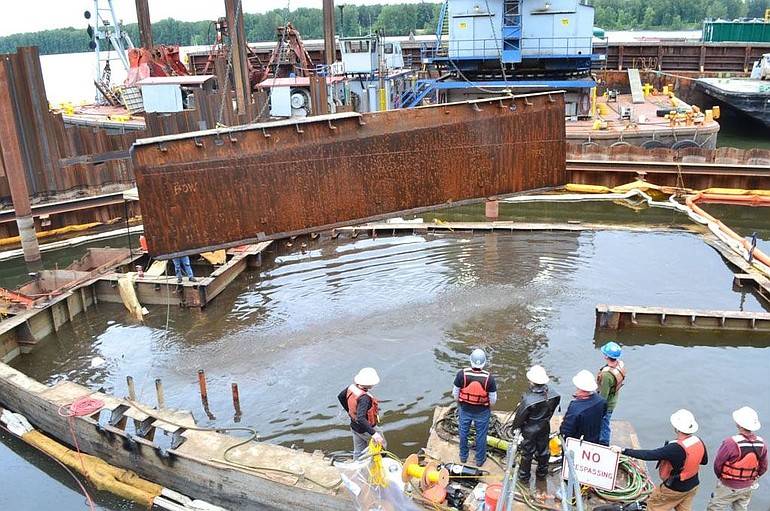With more than 80 percent of the vessel now gone, the dismantling of the Davy Crockett continues at a steady clip.
But even with an aggressive work pace — crews have pulled as much as 50,000 pounds of steel from the broken vessel in a single day — officials now say it could be late August or September before the broken liberty ship-turned-barge is gone from the north bank of the Columbia River near Camas.
“They’ve been pretty much working on this thing seven days a week, almost nonstop,” said U.S. Coast Guard Petty Officer Shawn Eggert.
The numbers continue to climb — 3.6 million pounds of steel removed, another 730,000 pounds of debris, more than 13,000 gallons of bunker oil and almost 5,000 pounds of asbestos.
And the cost stands at $16.6 million to date, paid for by the federal Oil Spill Liability Trust Fund.
At this point, most of the work is taking place underwater, said Kim Schmanke, a Washington State Department of Ecology spokesperson. Recent photos show little remaining of the 431-foot vessel.
“We’re down to about the last 100 feet of bow section,” Schmanke said.
Owner investigated
The saga began in January, when Davy Crockett owner Brett Simpson attempted to scrap the damaged vessel while it was afloat. Instead, the vessel buckled and partially sank, releasing oil and debris into the Columbia River.
Later that month, state Department of Ecology officials traced an oil sheen 15 miles away from the Davy Crockett. That’s when federal authorities took over dismantling and cleanup of the broken vessel. Simpson has not been involved in that process, but has been the subject of a federal criminal investigation.
Eggert did not comment on the status of that investigation this week.
Officials originally planned to take the vessel out of the water before dismantling it. But after no dock would accept the crippled ship, crews began the unusual step of taking it apart, piece by piece, where it sat in the water.
Workers built a metal cofferdam around the former Navy Liberty Ship, creating a barrier to keep more oil and debris from leaking into the river. A silt barrier reinforces that wall, rising and falling with the water level. The barrier held up amid high water earlier this year, when rain and snowmelt pushed the Columbia River well above flood stage.
“It’s worked as we’ve anticipated it would work,” Schmanke said.
Even when the vessel is gone, the project won’t end. Then comes the next job: cleaning up after the cleanup.
Crews continue to take samples of sediment from the river, testing for possible contamination where the vessel sat for months. But much of that impact may not be known until the barge is removed, Schmanke said.
Some 1.6 million gallons of oil-water mixture has been recovered from the Davy Crockett site, according to the Department of Ecology. Filtered wastewater will be disposed of through the city of Portland’s wastewater treatment system. It won’t be discharged directly back into the Columbia.
One of the final steps in the cleanup process is the removal of the cofferdam itself — an action that won’t be taken until after necessary sediment cleanup is done, according to the Department of Ecology.
It’s unclear when the cofferdam may come out of the water for good, Schmanke said. Until then, the unique operation continues.
“I can’t recall a time when we’ve done this, especially when the boat was still in the water, submerged,” Eggert said. “If it has been done in the past, it’s fairly rare.”




